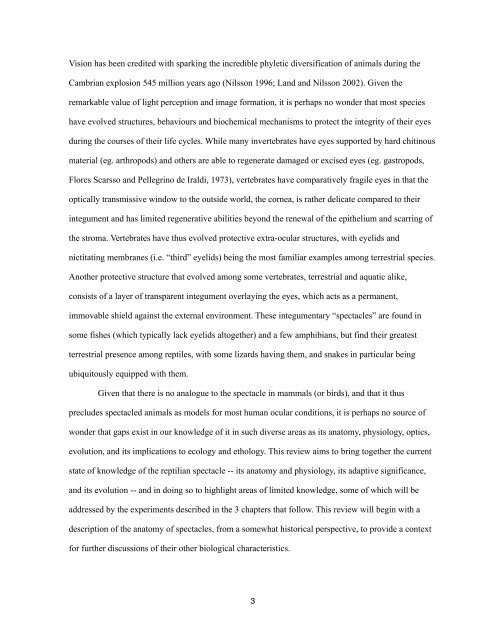Chapter 1, The Reptilian Spectacle - UWSpace - University of ...
Chapter 1, The Reptilian Spectacle - UWSpace - University of ...
Chapter 1, The Reptilian Spectacle - UWSpace - University of ...
You also want an ePaper? Increase the reach of your titles
YUMPU automatically turns print PDFs into web optimized ePapers that Google loves.
Vision has been credited with sparking the incredible phyletic diversification <strong>of</strong> animals during the<br />
Cambrian explosion 545 million years ago (Nilsson 1996; Land and Nilsson 2002). Given the<br />
remarkable value <strong>of</strong> light perception and image formation, it is perhaps no wonder that most species<br />
have evolved structures, behaviours and biochemical mechanisms to protect the integrity <strong>of</strong> their eyes<br />
during the courses <strong>of</strong> their life cycles. While many invertebrates have eyes supported by hard chitinous<br />
material (eg. arthropods) and others are able to regenerate damaged or excised eyes (eg. gastropods,<br />
Flores Scarsso and Pellegrino de Iraldi, 1973), vertebrates have comparatively fragile eyes in that the<br />
optically transmissive window to the outside world, the cornea, is rather delicate compared to their<br />
integument and has limited regenerative abilities beyond the renewal <strong>of</strong> the epithelium and scarring <strong>of</strong><br />
the stroma. Vertebrates have thus evolved protective extra-ocular structures, with eyelids and<br />
nictitating membranes (i.e. “third” eyelids) being the most familiar examples among terrestrial species.<br />
Another protective structure that evolved among some vertebrates, terrestrial and aquatic alike,<br />
consists <strong>of</strong> a layer <strong>of</strong> transparent integument overlaying the eyes, which acts as a permanent,<br />
immovable shield against the external environment. <strong>The</strong>se integumentary “spectacles” are found in<br />
some fishes (which typically lack eyelids altogether) and a few amphibians, but find their greatest<br />
terrestrial presence among reptiles, with some lizards having them, and snakes in particular being<br />
ubiquitously equipped with them.<br />
Given that there is no analogue to the spectacle in mammals (or birds), and that it thus<br />
precludes spectacled animals as models for most human ocular conditions, it is perhaps no source <strong>of</strong><br />
wonder that gaps exist in our knowledge <strong>of</strong> it in such diverse areas as its anatomy, physiology, optics,<br />
evolution, and its implications to ecology and ethology. This review aims to bring together the current<br />
state <strong>of</strong> knowledge <strong>of</strong> the reptilian spectacle -- its anatomy and physiology, its adaptive significance,<br />
and its evolution -- and in doing so to highlight areas <strong>of</strong> limited knowledge, some <strong>of</strong> which will be<br />
addressed by the experiments described in the 3 chapters that follow. This review will begin with a<br />
description <strong>of</strong> the anatomy <strong>of</strong> spectacles, from a somewhat historical perspective, to provide a context<br />
for further discussions <strong>of</strong> their other biological characteristics.<br />
3
















